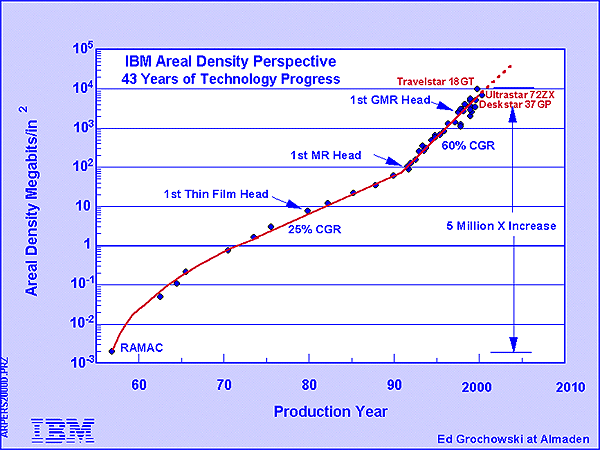[ The PC Guide | Systems and Components Reference Guide | Hard Disk Drives | A Brief History of the Hard Disk Drive ]
Hard Disk Trends
The most amazing thing about hard disks is that they both change and don't change more than most other components. In terms of their basic design, today's hard disks aren't a lot different than the 10 MB clunkers installed in the first IBM PC/XTs in the early 1980s. However, in terms of their capacity, storage, reliability and other characteristics, hard drives have probably improved more than any other PC component. Let's take a look at some of the trends in various important hard disk characteristics:
- Areal Density: The areal density of hard disk platters continues to increase at an amazing rate even exceeding some of the optimistic predictions of a few years ago. Densities in the lab are now exceeding 35 Gbits/in2, and modern disks are now packing as much as 20 GB of data onto a single 3.5" platter!
|
This chart shows the progress of areal density over the
last 43 years. The red line is drawn |
Image � IBM Corporation |
- Capacity: Hard disk capacity continues to not only increase, but increase at an accelerating rate. From 10 MB in 1981, we are now well over 10 GB in 2000 and will probably hit 100 GB within a year for consumer drives.
- Spindle Speed: The move to faster and faster spindle speeds continues. Since increasing the spindle speed improves both random-access and sequential performance, this is likely to continue. Once the domain of high-end SCSI drives, 7200 RPM spindles are now standard on mainstream IDE/ATA drives. A 15,000 RPM SCSI drive was announced by Seagate in early 2000.
- Form Factor: The trend in form factors is downward: to smaller and smaller drives. 5.25" drives have now all but disappeared from the mainstream PC market, with 3.5" drives dominating the desktop and server segment. In the mobile world, 2.5" drives are the standard with smaller sizes becoming more prevalent; IBM in 1999 announced its Microdrive which is a tiny 170 MB or 340 MB device only an inch in diameter and less than 0.25" thick! Over the next few years, desktop and server drives are likely to transition to the 2.5" form factor as well. The primary reasons for this "shrinking trend" include the enhanced rigidity of smaller platters, reduction of mass to enable faster spin speeds, and improved reliability due to enhanced ease of manufacturing.
- Performance: Both positioning and transfer performance factors are improving. The speed with which data can be pulled from the disk is increasing more rapidly than positioning performance is improving, suggesting that over the next few years addressing seek time and latency will be the areas of greatest value to hard disk engineers.
- Reliability: The reliability of hard disks is improving slowly as manufacturers refine their processes and add new reliability-enhancing features, but this characteristic is not changing nearly as rapidly as the others above. One reason is that the technology is constantly changing, and the performance envelope constantly being pushed; it's much harder to improve the reliability of a product when it is changing rapidly.
- RAID: Once the province of only high-end servers, the use of multiple disk arrays to improve performance and reliability is becoming increasingly common, and is now even seen in consumer desktop machines. Over the next few years I predict that RAID will become the "next big thing" as the thirst for performance increases, and in five years we may see new PCs commonly shipping with multiple hard disks configured as an array.
- Interfaces: Despite the introduction to the PC world of new interfaces such as IEEE-1394 and USB (universal serial bus) the mainstream interfaces in the PC world are the same as they were through the 1990s: IDE/ATA and SCSI. The interfaces themselves continue to create new and improved standards with higher maximum transfer rates, to match the increase in performance of the hard disks themselves.
![]() Next: Construction
and Operation of the Hard Disk Drive
Next: Construction
and Operation of the Hard Disk Drive
| The PC Guide
(http://www.PCGuide.com) Site Version: 2.2.0 - Version Date: April 17, 2001 © Copyright 1997-2004 Charles M. Kozierok. All Rights Reserved. |
Not responsible for any loss resulting from the use of this site. Please read the Site Guide before using this material. |
